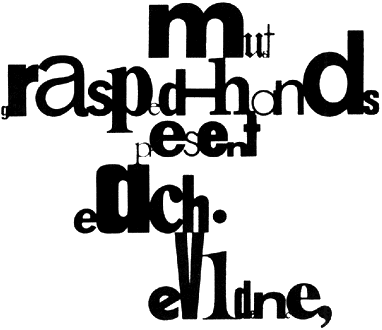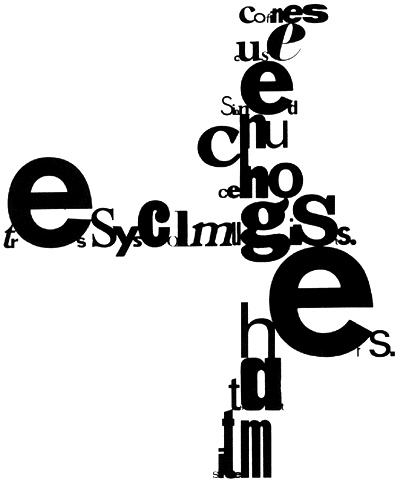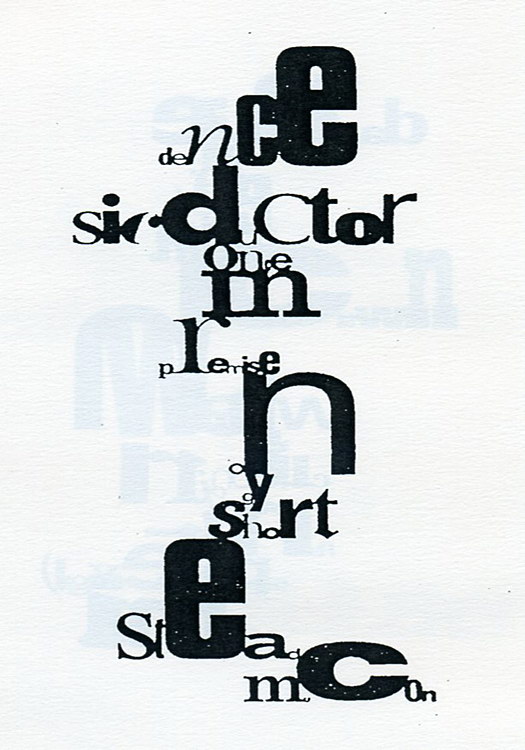REPRESENTING THE CITY | visual encyclopedia for the ghetto:
An interactive web site by the photographer Camilo José Vergara
DOCUMENTARY | Camilo Vergara Documents the Changing Urban Landscape
MESOSTICS | creative writings and visual arts:
The American Composer John Cage invented what can only be described as a postmodern poetic form in his mesostics. These writings, though they started out as purely creative, eventually became poems generated by chance operations. The mesostics emerged as another product of Cage’s exploration of indeterminacy. Some of Cage’s works that included these poems are his Norton Lectures texts (also known as I-VI), Sixty-Two Mesostics Re: Merce Cunningham, and Roaratorio. Cage used chance operations for other forms of writing too. For example, his Diary: How to Improve the World (You Will Only Make Matters Worse) used subway train schedules and other sources to decide on typefaces, the number of sections per day, margins, and a myriad of other characteristics. In his early mesostics, Cage would simply write a word (usually a name) vertically down the page, with all the letters capitalized. Then, he would “fill in the blanks” and come up with a poem using the “spine” he had chosen. Cage dubbed these poems “acrostics” until Norman O. Brown pointed out that acrostics had their “spine” letters on the edges of the words, not down the middle. Cage renamed the poems “Mesostics”, a word derived from “Acrostic”, but with an indication that the vertical aspect is in the middle of the word.
According to Cage, in a “pure mesostic”, there are no repeated lower case letters that match the previous or next upper-case letter in the poem. The words that surround the spine letters are taken from a selected source text read forwards, or by chance operations. The first letter to appear in any word is used to surround the corresponding spine letter. “Wing Words”, or intermittent words placed in the text between spine words, may be selected by one’s taste or through further chance operations. They must, however, obey the non-repeating letter rule.
It should be noted that Cage was not the first to write poetry using these methods. Acrostic poems were a favorite of Lewis Carroll, and Jackson MacLow apparently used Cage’s chance music techniques to write poetry as early as 1950. MacLow’s works, however, include what he dubbed “Diastics” – the spine word begins on the first letter of the first line, then moves to the second letter of the second line, and so on. A critical view of such works might lead one to believe that these writings are meaningless, and simply a fast way of generating poetry quickly. The latter is true, but in reality they can be very complex.
HERE SOME EXAMPLES OF MESOSTICS
PERFORMANCE | instrumental voice:
Efstratios Dimitriou (Greek: Ευστράτιος Δημητρίου; April 22, 1945 – June 13, 1979) better known as Demetrio Stratos was a Greek-born Italian lyricist, multi-instrumentalist, music researcher, and co-founder, frontman and lead singer of the Italian progressive rock, jazz fusion band Area – International POPular Group.
Born and raised in Alexandria, Egypt, of Greek parents, he studied piano and accordion at the “National Conservatoire”. In 1957 he was sent to Nicosia, Cyprus, and, at the age of 17, moved to Milan, Italy, to attend the Politecnico di Milano University at the Architecture Faculty, where he formed his first musical group. In 1967, Demetrio Stratos joined the Italian beat band I Ribelli, and in 1972, founded Area.
Stratos recorded many records, and toured festivals in Italy, France, Portugal, Switzerland, Netherlands, Cuba, U.S. with Area, as well as a solo artist and in collaboration with other artists. He worked together with musicians, singers, writers, poets, directors, men of learning such as Mogol, Lucio Battisti, Gianni Sassi, Gianni Emilio Simonetti, Juan Hidalgo, Walter Marchetti, John Cage, Tran Quang Hai, Merce Cunningham, Jasper Johns, Andy Warhol, Grete Sultan, Paul Zukofsky, Nanni Balestrini, Claude Royet-Journoud, and Antonio Porta.
He studied ethnomusicology, vocal extensions, Asian music chant, compared musicology, the problem of ethnic vocality, psychoanalysis, the relationship between spoken language and the psyche, the limits of the spoken language. He was able to reach 7,000 Hz, and to perform diplophony, triplophony, and also quadrophony. Daniel Charles has described him as the person who decimated monody by the demultiplication of the acoustic spectrum. His vocal abilities were explored and documented.
Stratos died in New York City Memorial Hospital on June 13, 1979 at the age of thirty–four. His mission was to free vocal expression from the slavery of language and pretty melodies. He considered the exploration of vocal potential as a tool of psychological and political liberation. His study of the voice used as a musical instrument carried him to reach for the limits of human capabilities. The amazing research of Stratos brings many suggestions of unexplored fields of research that are still to be studied.
[text from wikipedia]
INTERPRETATION OF CAGE’S MESOSTICS BY DEMETRIO STRATOS
VOICE PERFORMANCE BY DEMETRIO STRATOS
SITE | creative writings and visual arts:
A Humunument: Visual-Poetic Artist’s Book




